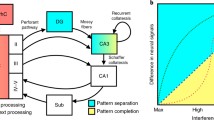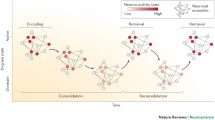Abstract
Despite abundant knowledge on the neural basis of memory functions in the human brain, stimulus-specific memory traces — engrams — have long remained elusive. In this article, recent developments that start to shed light on the mechanisms underlying the formation, modification and potential degradation of engrams are reviewed. Stimulus-specific memory representations appear to occur at different levels of brain organization, from spike rates of individual cells via time-frequency signatures of small-scale neural networks to distributed activity patterns. However, memories undergo transformation whenever they are recalled. Thus, novel methodological approaches need to be employed in order to identify considerably modified engrams. Furthermore, engrams are impaired in a number of diseases involving memory dysfunction. This article is concluded with a description of recent translational work on altered content-specific memory representations in the context of Alzheimer’s disease.





Similar content being viewed by others
References
Assmann A (1999) Erinnerungsräume. Formen und Wandel des kulturellen Gedächtnisses. C.H. Beck, München
Axmacher N, Do LAT, Kessler H, Fell J (2010) Natural memory beyond the storage model: repression, trauma, and the construction of a personal past. Front Hum Neurosci 4:211
Deuker L, Olligs J, Fell J, Kranz TA, Mormann F, Montag C, Reuter M, Elger CE, Axmacher N (2013) Memory consolidation by replay of stimulus-specific neural activity. J Neurosci 33(49):19373–19383
Ekstrom AD, Kahana MJ, Caplan JB, Fields TA, Isham EA, Newman EL, Fried I (2003) Cellular networks underlying human spatial navigation. Nature 425(6954):184–188
Kunz L, Schröder TN, Lee H, Montag C, Lachmann B, Sariyska R, Reuter M, Stirnberg R, Stöcker T, Messing-Floeter PC, Fell J, Doeller CF, Axmacher N (2015) Reduced grid-cell-like representations in adults at genetic risk for Alzheimer’s disease. Science 350(6259):430–433
Lashley KS (1950) In search of the engram. Symp Soc Exp Biol 4:454–482
Quiroga RQ, Reddy L, Kreiman G, Koch C, Fried I (2005) Invariant visual representation by single neurons in the human brain. Nature 435(7045):1102–1107
Staresina BP, Alink A, Kriegeskorte N, Henson RN (2013) Awake reactivation predicts memory in humans. Proc Natl Acadsci USA 110(52):21159–21164
van Gerven MA, Maris E, Sperling M, Sharan A, Litt B, Anderson C, Baltuch G, Jacobs J (2013) Decoding the memorization of individual stimuli with direct human brain recordings. Neuroimage 70:223–232
Zhang H, Fell J, Staresina BP, Weber B, Elger CE, Axmacher N (2015) Gamma power reductions accompany stimulus-specific representations of dynamic events. Curr Biol 25(5):635–640
Author information
Authors and Affiliations
Corresponding author
Ethics declarations
Conflict of interest
N. Axmacher states that there are no conflicts of interest.
The accompanying manuscript does not include studies on humans or animals.
Rights and permissions
About this article
Cite this article
Axmacher, N. In search of the human engram. e-Neuroforum 7, 31–36 (2016). https://doi.org/10.1007/s13295-016-0023-5
Published:
Issue Date:
DOI: https://doi.org/10.1007/s13295-016-0023-5




